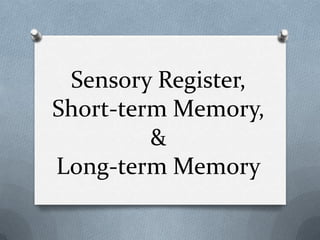
Improve Sensory Registration and Memory with Clear Presentation
- 1. Sensory Register, Short-term Memory, & Long-term Memory
- 2. Sensory Registers O are the physiological parts of the nervous system where electro- chemical activity takes place in response to the activity of sense organs, such as the eye and ear.
- 3. O The basic capabilities of the sensory register develop when learners are very young. O These capabilities continue to develop, and developing the skills of the sensory register may be the primary goal of instruction.
- 4. O However, in most cases, the goal of teachers of school-age and adult learners is to bring these sensory skills under deliberate control and to employ them as effective contributors to the working memory.
- 5. 2 problems that can occur as information moves from the sensory register working memory: 1. Not enough input may move forward (that is, information may be forgotten before it has ever had a chance to be remembered). Solution: Train the senses to register information accurately and by having meaningful related information actively available in working memory and easily accessible in long-term memory.
- 6. 2. Too much input may move forward (that is, the working memory may be overwhelmed by excessive input that it cannot handle). Solution: Screen information effectively.
- 7. What to Do to Help the Learner Transfer Information Correctly from the External Source into the Sensory Register. 1. Make sure the information is clearly available in the first place. O Don't use faulty materials that render information partially incomprehensible. O Speak clearly. O Draw diagrams that the students can see. O Speak in a language that the students can understand.
- 8. 2. Minimize factors that will interfere with the proper reception of information in the sensory register. O previously learned information is lost because it is mixed up with new and somewhat similar information. 3. Repeat the presentation more than a single time. It's actually unlikely that any information will be perfectly received, and redundancy will reduce errors. 4. Check to verify whether the information has been received correctly.
- 9. Careful presentation of information enables learners to get it correctly into the sensory register.
- 10. You are about to do a small short-term memory test
- 11. A few letters will flash on your computer monitor for 3 seconds
- 12. Write down as many letters as you can remember after they disappear
- 13. Templates of the tables needed are made ready for you:
- 14. Trial # The Letters I remembered are: 1 2 3 4 5 6
- 15. Total # of % you Total # of letters Trial # Correct Letters letters you remembere in the set remembered d 1 2 3 4 5 6
- 16. Let’s START!!!
- 17. UM
- 18. Continue….
- 19. TZLD
- 20. Continue….
- 21. KXCEJO
- 22. Continue….
- 23. AVCYISEH
- 24. Continue….
- 25. LBFQRPMAUX
- 26. Continue….
- 27. ZQECTBUMONRV
- 28. Let’s check…
- 29. remembere d Trial # ÷ Total # of letters # of letters Correct Letters x 100 = Total # of letters you % you remembere in the set remembered d UM 1 2 TZLD 2 4 KXCEJO 3 6 AVCYISEH 4 8 LBFQRPMAUX 5 10 6 12 ZQECTBUMONR V
- 30. Short-term memory O is the capacity for holding a small amount of information in mind in an active, readily available state for a short period of time. O The duration of short-term memory (when rehearsal or active maintenance is prevented) is believed to be in the order of seconds. A commonly cited capacity is 7 ± 2 elements.
- 31. Long-term memory O is memory in which associations among items are stored, as part of the theory of a dual-store memory model. O According to the theory, long-term memory differs structurally and functionally from working memory or short-term memory, which ostensibly stores items for only around 20–30 seconds and can be recalled easily.
